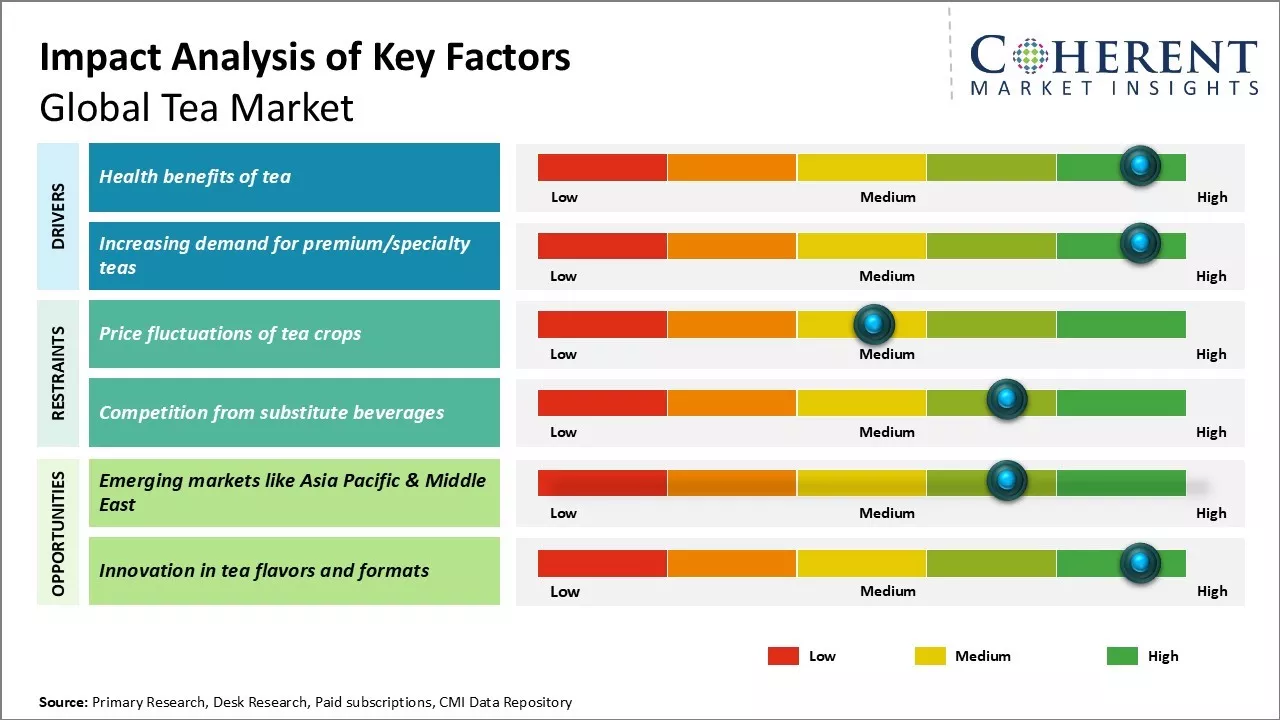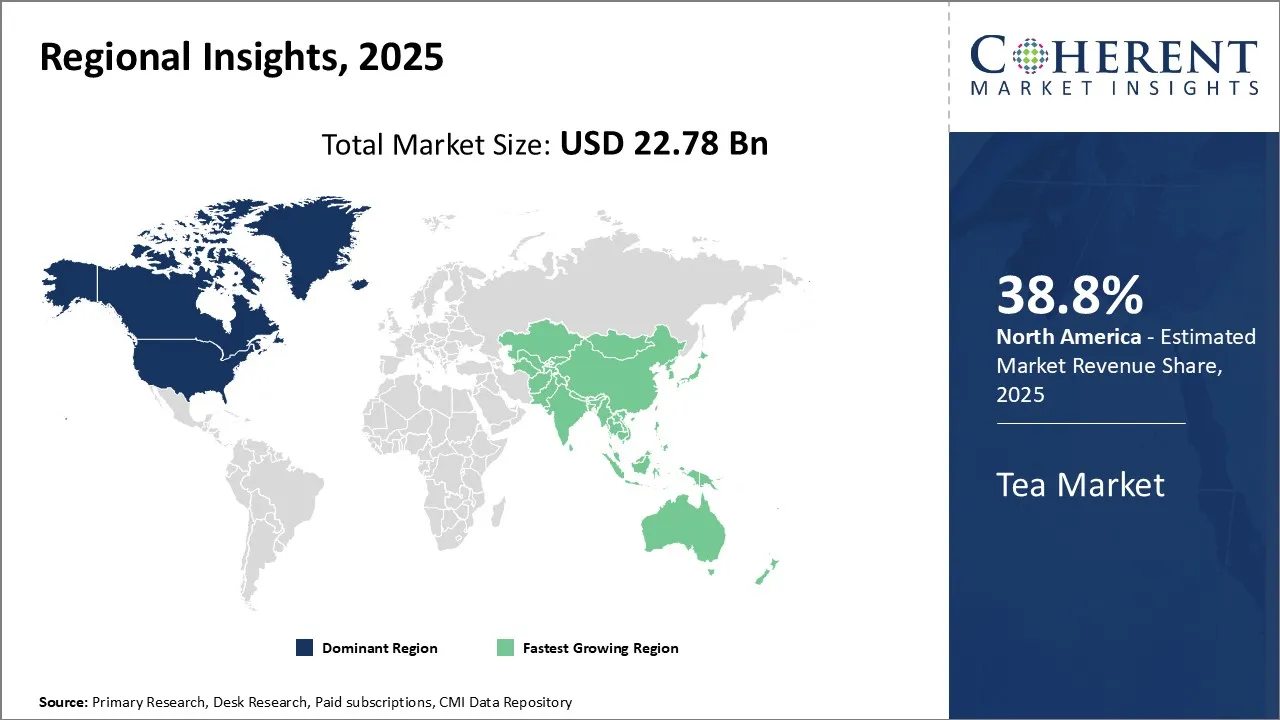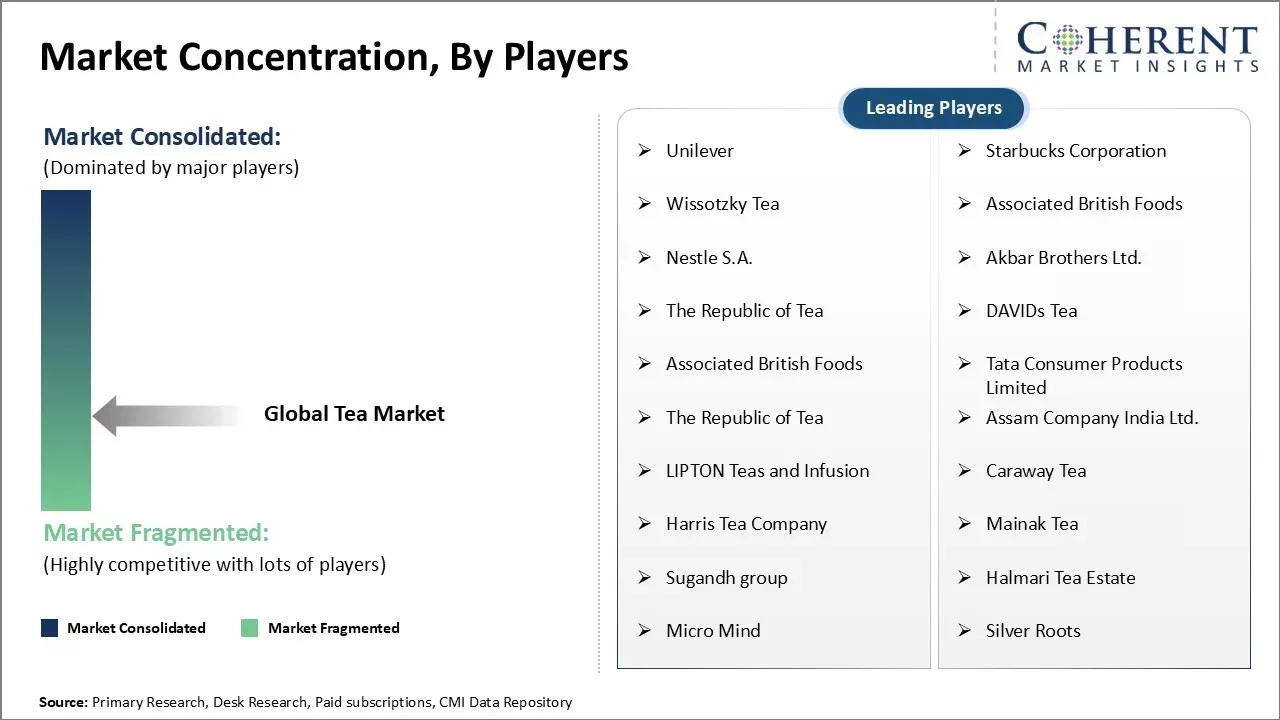The global tea market is estimated to be valued at USD 22.78 Bn in 2025 and is expected to reach USD 34.96 Bn by 2032, exhibiting a compound annual growth rate (CAGR) of 6.3% from 2025 to 2032.

To learn more about this report, Download Free Sample
Rising awareness about the health benefits of tea consumption is driving the market growth. Some of the major health benefits of tea include improved heart health, bone strength, mental alertness, and weight management. Increasing disposable incomes in developing regions is also supporting the growing preference for specialty teas.
|
Current Event |
Description and its Impact |
|
Climate Change and Weather Disruptions |
|
|
Technological Innovations and Market Evolution |
|
Uncover macros and micros vetted on 75+ parameters: Get instant access to report
In terms of tea type, black tea is expected to contribute 39.2% share of the market in 2025, owing to its various health benefits attracting consumers globally. Black tea contains antioxidants called polyphenols that protects cells from damage and reduces the risk of chronic diseases. The high levels of flavonoids and other antioxidants in black tea are known to improve cardiovascular health by lowering blood pressure and cholesterol levels, thereby decreasing the risk of heart attacks and strokes. The presence of theaflavins and thearubigins in black tea also provides anti-inflammatory and anti-carcinogenic properties protecting against cancers.
Black tea is a rich source of vitamin C, vitamin K, manganese, and other nutrients. The growing health consciousness and disease preventive lifestyle among populations is increasing the consumption of black tea for its immunity boosting and longevity enhancing properties.
For instance, in October 2025, India's first decaffeinated black tea been launched by CSIR-NEIST, Jorhat, using indigenous technology. Developed from Assam-grown tea leaves, this innovation offers a caffeine-free alternative while preserving the flavor and health benefits of traditional black tea. The breakthrough is expected to boost Assam’s tea industry and cater to health-conscious consumers nationwide.
In terms of tea form, the loose leaf tea segment is expected to contribute 45% share of the market in 2025, owing to consumer's growing preference for variety and superior experience. Loose leaf tea offers a diverse assortment of flavors, grades, regions and cultivars providing connoisseurs with numerous options to choose from according to individual taste and mood. The leaves maintain their essential oils allowing for distinctive aromatic infusion and rich flavor profile compared to other forms. Prizing loose leaves also provides a satisfying ritual and experience for tea drinkers as it allows controlling infusion time, water temperature and leaf quantity for a perfectly balanced cup.
For instance, in July 2025, Assam-based startup Woolah Tea secured a patent for India’s first bagless tea, revolutionizing the tea-drinking experience. The innovation uses compressed whole leaf bundles tied with natural string, eliminating the need for conventional tea bags. This eco-friendly product promotes purity and convenience, with plans to expand exports to the US, UK, UAE, Australia, and New Zealand.
In terms of distribution channel, the supermarkets/hypermarkets segment is expected to contribute 49.1% share of the market in 2025, owing to their wide global reach and dominance as a one-stop shopping destination. Large retailers command an extensive supply chain network allowing comprehensive assortments of popular national and international tea brands under one roof. Their massive store sizes and inventory capacities also ensure optimum economies of scale in procurement. Furthermore, the proliferation of private label and store brand tea products developed by such retailers offers good quality options at competitive prices attracting price-sensitive buyers.
For instance, in June 2025, Indian Coffee House launched its own branded tea in collaboration with Kerala’s Priyadarshini Tea Estate. The new product marks the chain’s entry into the packaged tea market, with plans to retail through supermarkets and its outlets. This initiative aims to expand its brand presence and offer quality tea directly to consumers.

To learn more about this report, Download Free Sample
North America holds the dominant position in the market, and it is expected to account for 38.8% of the market share in 2025, due to rising health consciousness, demand for functional beverages, and growing interest in herbal and specialty teas. Consumers are shifting from sugary drinks to natural alternatives, boosting sales of green, black, and ready-to-drink teas. Sustainability and premium quality also drive retail and out-of-home tea consumption.
For instance, in November 2025, Lipton expanded its product line to include tea concentrates and herbal blends, targeting the growing demand for functional and customizable beverages in North America. The move reflects shifting consumer preferences toward health-focused, convenient drink options. Lipton aims to appeal to younger, wellness-conscious consumers seeking variety and personalization in their tea choices.
Asia Pacific region is experiencing the fastest growth, due to rising health awareness, urbanization, and disposable incomes. Consumers are increasingly choosing premium, functional teas like green and herbal blends. Convenience products and online retail growth also fuel demand. The region’s deep-rooted tea culture and innovation in packaging further strengthen its global dominance.
For instance, in October 2025, Tata Tea Agni launched “Extra Josh,” India’s first tea with added natural caffeine, targeting consumers seeking a stronger energy boost. The blend combines traditional tea with enhanced caffeine content sourced from natural ingredients. This innovation aims to energize the mass-market segment while reinforcing Tata Tea Agni’s bold and invigorating brand identity.
In 2025, the U.S. tea market is thriving due to rising health consciousness, demand for functional beverages, and interest in natural energy alternatives. Consumers are embracing herbal, green, and ready-to-drink teas for wellness benefits. Innovations in flavor, sustainability, and convenience, along with younger demographics seeking low-caffeine options are fueling steady growth across retail and foodservice channels.
For instance, in October 2025, Caraway Tea Company unveiled a groundbreaking infusion technology that merges tea with dietary supplements, offering enhanced wellness benefits. This innovation delivers functional ingredients like vitamins and adaptogens through everyday tea consumption. The launch marks a significant step in personalized health beverages, catering to consumers seeking convenience, nutrition, and holistic well-being in one cup.
China’s tea market is booming in 2025 due to rising health awareness, demand for premium products, and strong cultural ties to tea consumption. Government support for traditional industries and innovation in flavors and packaging attract younger consumers. Expanding online retail and domestic tourism further fuel growth, making China a global leader in tea demand.
For instance, in November 2025, iTeaworld launched the world’s first structured Yin Zhi scented tea collections, reviving a millennium-old Chinese tea craft. This innovative line blends traditional techniques with modern presentation, offering a refined sensory experience. The launch marks a milestone in premium tea innovation, celebrating heritage while appealing to global connoisseurs seeking authenticity and elegance.
| Report Coverage | Details | ||
|---|---|---|---|
| Base Year: | 2024 | Market Size in 2025: | USD 22.78 Bn |
| Historical Data for: | 2020 To 2024 | Forecast Period: | 2025 To 2032 |
| Forecast Period 2025 to 2032 CAGR: | 6.3% | 2032 Value Projection: | USD 34.96 Bn |
| Geographies covered: |
|
||
| Segments covered: |
|
||
| Companies covered: |
Unilever, Starbucks Corporation, Wissotzky Tea, Associated British Foods, Nestle S.A., Akbar Brothers Ltd., The Republic of Tea, DAVIDs Tea, Associated British Foods, Tata Consumer Products Limited, The Republic of Tea, Assam Company India Ltd., LIPTON Teas and Infusion, Caraway Tea, Harris Tea Company, Mainak Tea, Sugandh group, Halmari Tea Estate, Micro Mind, and Silver Roots |
||
| Growth Drivers: |
|
||
| Restraints & Challenges: |
|
||
Uncover macros and micros vetted on 75+ parameters: Get instant access to report
Tea is widely regarded as one of the healthiest beverages globally, thanks to its rich antioxidant content and diverse health benefits. Green tea, known for boosting metabolism and aiding weight loss, contains EGCG, which protects cells from damage. Oolong tea supports cholesterol reduction, black tea enhances bone health, and white tea offers antiviral properties. Growing health awareness and medical research have elevated tea’s status as a superfood, encouraging daily consumption. The availability of various tea types and promotion of their wellness traits have increased consumer interest. As a result, tea market share continues to expand, driven by lifestyle shifts and wellness trends.
For instance, in February 2025, Harvard Health Publishing explored the health benefits of tea, highlighting its rich antioxidant content and potential to support heart health, brain function, and weight management. The article notes that compounds like flavonoids and catechins in tea may reduce inflammation and protect cells. While more research is needed, tea remains a widely recommended beverage for overall wellness.

To learn more about this report, Download Free Sample
The steady rise in tea consumption has sparked growing demand for premium varieties, influencing tea market price trends. Consumers are exploring white, oolong, and exotic infusions with fruits, spices, or herbs like turmeric and holy basil. Small producers and importers now focus on high-quality loose-leaf teas, while tea boutiques and cafes offer curated experiences. E-commerce has boosted visibility for artisanal growers, and festivals, tastings, and wellness influencers have elevated niche teas. The luxury appeal of rare or single estate teas attracts affluent buyers. With quality prioritized over quantity, premium teas now command higher prices and represent a larger share of total market revenue.
The global tea market is witnessing impressive growth opportunities in the emerging markets of Asia Pacific and Middle East regions. In the Asia Pacific region, countries like China, India, and Vietnam have a deep-rooted tea culture and collectively represent over 50% of global tea consumption. However, per capita consumption in these countries is still lower than developed Western nations. With rising incomes, urbanization and evolving lifestyles, tea demand in Asia Pacific is projected to grow at over 5% annually in the coming years. Similarly, the Middle East market led by Gulf countries is at a nascent stage and offers immense headroom for growth. Factors such as surging expat population, adaptation of western food habits, and health awareness are fueling higher tea intake. Leveraging the demographics and economic growth trends, tea manufacturers have scope to capture additional market share in these emerging territories through customized products, innovative packaging and intensive marketing initiatives. This can substantially boost global tea market revenues in the long run.
The global tea market value is undergoing a strategic shift from a commodity-based to a value-driven industry, shaped by health consciousness, sustainability, and regional authenticity. Premiumization and wellness-oriented formulations are redefining consumer expectations. According to the Tea Association of the U.S.A., over 25% of new tea launches in 2023 incorporated functional ingredients such as turmeric and ginger, reflecting the fusion of traditional remedies with modern wellness trends.
Origin-based branding is strengthening, with teas like Darjeeling, Matcha, and Ceylon positioned as symbols of quality and cultural heritage. Data from India’s Tea Board shows specialty tea exports rising by over 9% year-on-year in 2024, signaling growing consumer appreciation for artisanal products. Concurrently, ready-to-drink and cold-brew teas are capturing younger audiences, as seen with Suntory’s Iyemon Tokucha range in Japan achieving double-digit growth through scientifically backed health claims.
Sustainability initiatives, such as Unilever’s 100% Rainforest Alliance sourcing and Tata Consumer Products’ regenerative cultivation pilots are improving brand credibility but raising production costs. Meanwhile, digital-first players like VAHDAM India are driving transparency and storytelling-led engagement, with over 70% of revenue from global e-commerce.
Ultimately, tea’s evolution hinges on authenticity, innovation, and responsible sourcing elements that now define competitive advantage in this maturing global market.
Definition: The global tea market includes all tea products that are manufactured, packaged, and sold across the world. It comprises products like black tea, green tea, oolong tea, and herbal tea. The tea market is growing steadily as demand rises in developing regions and new healthy beverage trends emerge. Key players in the global tea market focus on expanding their international reach, investing in sustainable sourcing and promoting various health benefits of tea to tap into new customer segments globally.
Share
Share
About Author
Sakshi Suryawanshi is a Research Consultant with 6 years of extensive experience in market research and consulting. She is proficient in market estimation, competitive analysis, and patent analysis. Sakshi excels in identifying market trends and evaluating competitive landscapes to provide actionable insights that drive strategic decision-making. Her expertise helps businesses navigate complex market dynamics and achieve their objectives effectively.
Missing comfort of reading report in your local language? Find your preferred language :
Transform your Strategy with Exclusive Trending Reports :
Frequently Asked Questions
Joining thousands of companies around the world committed to making the Excellent Business Solutions.
View All Our Clients